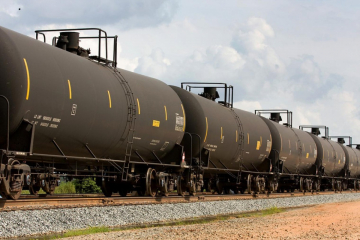Railroad Industry experts discuss how nature-based solutions can address environmental and engineering needs while restoring natural landscapes.
Nathan Loftice, Director of Planning and Sustainability at BNSF and Peter Masson, Railroad Industry expert at Antea Group, discuss how nature-based solutions can address environmental and engineering needs while restoring natural landscapes.
This article was originally published in the American Railway Development Association (ARDA) March 2020 newsletter.
What are Nature-based Solutions?
The goal of nature-based solutions (NBS) is to address environmental and engineering needs while restoring natural landscapes. NBS, also known as green infrastructure, imitate processes in the natural environment to provide clean water, clean air, flood, fire and drought risk reduction, and other benefits in the world of industrial infrastructure. Such solutions can also offer economic, social, and environmental benefits to the community. As more and more communities begin to require green infrastructure as an element of new developments it may be time for the railroads to start considering NBS, and here is why.
Examples of NBS
Water Treatment: One of the main applications of NBS is to treat stormwater and wastewater. This can be accomplished through the use of constructed wetlands, a natural method of filtering water by using wetland vegetation to trap suspended solids while plants and microorganisms take up other pollutants. Constructed wetlands are often cheaper to build and require lower operating costs than a wastewater treatment plant but often require more physical space.
Treatment channels can be created within naturally occurring streams to treat industrial water by selecting rocks such as limestone that can buffer acid water and increase retention times. As the water quality improves, fish and other wildlife will be able to move into the restored habitat.
Reducing Stormwater Runoff: If there is less water running off into streams and rivers, there is less chance of contaminating those waterways. Bioswales are shallow ditches that are designed to manage stormwater runoff from nearby impervious surfaces – such as roads and parking lots – and protect nearby water bodies by reducing floatables, nutrients, pesticides, sediments, and suspended solids, as well as slowing and reducing the amount of runoff. Like bioswales, bioretention ponds can treat stormwater runoff and reduce its volume by allowing retained water to infiltrate the ground or evapotranspire.
More and more buildings are incorporating green roofing by overlaying traditional roofs with a waterproof membrane, soil, and plants. Green roofs reduce stormwater runoff by allowing the plants to absorb stormwater directly while also slowing the rate at which stormwater flows into the sewer system. Additionally, green roofs can reduce ambient air temperatures along with building energy requirements.
Erosion Control: Another means to protect water resources is by implementing best management practices (BMPs) during construction and operations. While most railroads are familiar with traditional BMPs like straw and waddle, more permanent BMPs can be created that include buffer strips of native vegetation to reduce sediments and nutrient-rich runoff from reaching nearby waterways. So called Green-Grey Hybrid approaches combine green NBS solutions with traditional infrastructure to maximize the benefits of both approaches.
Reduced Irrigation and Maintenance Needs: As the climate continues to change and populations grow the need to steward water resources becomes more pressing. Strategic planting can reduce water use by incorporating both native landscapes and xeriscaping. Plants and grasses that are native to the region often require less water than decorative imports. Xeriscaping refers to landscapes that are designed to require less irrigation, whether they use native plants or not. Both landscaping tactics are more resistant to disease and drought and result in reduced maintenance costs and fewer emissions due to less mowing and water production needs.
Reuse of Decommissioned Sites: In the U.S. large areas of unused land can be restored or enhanced to provide important habitats for plants and animals. Often these restored habitats can be sold as compensatory mitigation credits or mitigation banks. The use of natural systems or processes in engineering to help restore and to further remediate the site is referred to as bioengineering. Often located in or near urban areas such projects can provide an educational benefit to the local community.
Drivers of NBS
Why should railroads consider implementing NBS? The following benefits can often drive the development of reasonable NBS plans and projects:
Lowering Project Costs: NBS can provide both short- and long-term financial savings by lowering operations and maintenance (O&M) costs. Some NBS solutions, such as constructed wetlands in lieu of wastewater treatment plants, cost less to build up front. Other NBS may require more upfront costs but, over time, will provide financial savings due to their reduced O&M expenses.
Managing Regulatory Requirements and Risk: Active operation sites can often suggest NBS to agencies that will, in turn, speed up the permitting process for stormwater projects; this agency cooperation can save a company time and money. For sites with existing or newly-created habitat, companies can mitigate their risk and create successful environmental outcomes through NBS investments in habitat. For properties that require restoration or remediation, NBS can help to facilitate the outcomes agreed upon with regulatory agencies.
Achieving Sustainability Goals: It is no surprise that corporate sustainability goals exemplify the multi-benefit argument in favor of NBS investment. Over the last several years more and more companies have published sustainability goals. The implementation of NBS within standard decision-making practices helps signal a company’s commitment to environmental practices and can contribute to enterprise-level financial goals.
Enhancing Marketing and Company Culture: NBS help companies demonstrate their commitment to sustainability and the environment. In ever-increasing numbers consumers intentionally choose brands that made their sustainability credentials more transparent. Similarly, NBS offer companies a tangible way to demonstrate to their employees that they care about the environment. Strategies like these will become increasingly important as millennials make up a larger share of the workforce and marketplace.
Mitigating Natural Disaster Risk: NBS can help reduce the damage natural disasters can cause in areas prone to flooding, landslides, fires, and extreme heat events.
Strategies for Operationalizing NBS
While the previous sections show demonstrable benefits to implementing NBS, many companies still struggle to consider them during development and redevelopment projects. Common barriers can include decentralized business operations, internal resistance to change, lack of in-house expertise to handle site-specific issues with NBS deployment, regulatory risk, lack of internal resources dedicated to these technologies, and perceived uncertainty in terms of costs and performance.
Like other sustainability initiatives, implementing NBS on a company-wide level starts from the top and works its way down. Operationalizing NBS requires leadership from across the company to provide the necessary set of opportunities and guidance for implementing NBS. For example, setting a companywide goal for NBS can help enable the leadership and culture change necessary to reduce the perceived uncertainty of cost and performance outcomes.
Companies with decision structures that encourage ongoing dialog between departments often find it easier to deploy NBS. Companies can also use decision-support tools to empower project decision-makers, such as site managers, to better utilize NBS alternatives. Decision-support tools can provide a structured framework for assessing economic, environmental and social benefits for all stakeholders.
Ultimately the company culture will need to evolve to support environmental solutions as being critical for the success of NBS adoption. Tactics for developing such a culture include organizing like-minded individuals into resource groups where they can share knowledge and experiences and proactively educate staff on the benefits of NBS. While top-level leadership buy-in on NBS can be critical, it is important to engage employees across all levels of the organization.
In the long run, NBS will not only benefit the environment it will also save our railroads money. If we can have the vision necessary to plan for the long term, we can start to implement NBS. Even in the short term, our projects will benefit from NBS.
So the real question is, why NOT use nature-based solutions now?
LEARN MORE ABOUT ALL THE SERVICES WE PROVIDE FOR THE RAILROAD INDUSTRY.
Want more news and insights like this?
Sign up for our monthly e-newsletter, The New Leaf. Our goal is to keep you updated, educated and even a bit entertained as it relates to all things EHS and sustainability.
Get e-Newsletter




